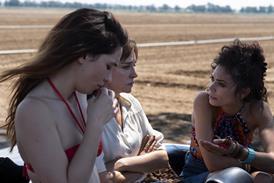On the eve of the annual Locations Trade Show in Los Angeles (April 16-18), Screen reports on why US producers are looking beyond their borders to international locationsmore than ever before.
A dramatically strengthened dollar. New financial incentives in two of Europe’s most photogenic countries. Uncertainty over incentive schemes in some cash-strapped US states. US producers and production executives have plenty of reasons for thinking globally when it comes to selecting locations for upcoming projects. And, though they emphasise their decisions are based on creative and logistical as well as financial concerns, some US production decision-makers say they are indeed now looking beyond their own shores on a regular basis.
‘Four months ago we were budgeting almost all of our films for the US,’ says Robert Katz, president of production at The Film Department. ‘Now on every one of our films we are looking internationally.’
In the months since the global financial crisis took hold with a vengeance, established international film-making hubs have been made significantly more attractive by the swing in exchange rates between the US dollar and most other currencies.
The UK, presently hosting projects including 20th Century Fox’s Gulliver’s Travels and Warner Bros’ next two Harry Potter films, has long been favoured by Hollywood for its crews, locations, studios and post-production facilities. And the simplification of the country’s tax rebate two years ago increased the appeal.
High labour and other costs have always been the downside, but over the past year the buying power of the US dollar in the UK has surged by 38%.
‘With the benefit of a better exchange rate it is much more viable to be shooting in London,’ confirms Andrew Fenady, president of physical production at Universal Pictures, which last year shot London-set period piece The Wolf Man in the UK, making use of locations that required ‘minimal augmentation’.
The UK incentive and exchange rate has also allowed Universal to stay on-budget through script rewrites and a major cast change on Ridley Scott’s Robin Hood (previously known as Nottingham), originally set to shoot in the UK last summer but now likely to start this spring.
The UK recently received another boost when Hollywood executives were schmoozed by Peter Robinson and Martin McGuinness, first minister and deputy first minister respectively of Northern Ireland, which offers its own financial incentive that can be combined with the UK rebate and the effect of the sterling exchange rate.
Universal, for one, is now considering shooting part of a film in Northern Ireland, making use of the region’s landscape and historic castles. ‘They also have a wonderful stage facility,’ says Fenady, ‘and the film has a significant build, so it seemed like a logical marriage.’
Germany, where Atlas Entertainment’s The International and United Artists’ Valkyrie have recently shot, is also renowned in Hollywood.
‘It’s got a fantastic infrastructure,’ says Richard Suckle, the Atlas executive who was one of the producers of The International. ‘Studio Babelsberg (which hosted and co-produced The International) is a great facility and the crew base is top notch.’
Germany also offers a slew of federal and state financial incentives. Its high wages and prices have also been slightly mitigated for US projects by the dollar’s 14% gain over the past year against the euro. The country’s combined attractions were enough to win over The Weinstein Company (TWC), whose Second World War project Inglourious Basterds shot mostly in Germany last year even though the greater part of the story is set in France.
‘It was a lot of different factors,’ says TWC head of physical production Tim Clawson of the decision to make Inglourious in Germany. ‘Even though it is set in occupied France it’s very much about World War Two Germany. Obviously the incentives factored in. And a lot of resources were available to us in Germany.’
Antipodean ‘one-stop shop’
Australia and New Zealand also remain high on Hollywood’s list of desirable overseas locations - because of their crews, facilities and even light, which production executives say appeals to talent.
Some of the countries’ US production work comes through links to star local film-makers such as Baz Luhrmann, whose Fox epic Australia shot in its title country, and Peter Jackson, whose involvement with DreamWorks’ The Lovely Bones and The Adventures Of Tintin: Secret Of The Unicorn and New Line/MGM’s The Hobbit helped bring all three projects to New Zealand.
But other US projects are also visiting Australia (much of New Zealand’s stage space is likely to be taken up by the Jackson projects), as Hollywood studios and independents take advantage of the country’s relatively modest 15% ‘location offset’ rebate for international productions - Australian-qualifying projects are eligible for the 40% ‘producer offset’ rebate - and its weak currency, against which the US dollar has gained 32% in the last 12 months.
Dan Hassid, vice-president and head of physical production at Miramax Films, says that after considering apparently cheaper locations in Europe his company will probably shoot its upcoming Guillermo del Toro-scripted horror thriller Don’t Be Afraid Of The Dark in Australia. ‘They have a good overall incentive and there is a broader range of things that qualify (than in other countries),’ says Hassid.
Andi Isaacs, executive vice-president of production at Summit Entertainment, which shot the sci-fi thriller Knowing in Australia, says the country represents ‘truly one-stop shopping. There are so many different things and looks that are available there. The crew rates are slightly lower and there are great visual effects companies.’
Knowing also, however, illustrates one of the dangers that US producers can face when dealing with international production incentives. Summit and Alex Proyas, the film’s Sydney-based director (also credited as one of the film’s producers and as having ‘adapted’ the screenplay) are presently tussling with Australian film authorities over whether the project will get the 15% or 40% rebate.
A Summit spokesman says: ‘Summit and Alex Proyas clearly believe the film should qualify for a rebate. There are very significant Australian elements and we’re in the process of re-applying for the 40%.’
Eastern premises
Where the more recently established production centres of Eastern Europe are concerned, US companies are benefitting from competition among countries eager for more inward investment.
Offering experienced, inexpensive labour - though no financial incentives - the Czech Republic remains a popular location for US productions and is this year set to host projects including Spyglass Entertainment’s Iron Bow and Lucasfilm’s Red Tails.
It is also the likely host, says Robert Katz, of The Film Department’s Second World War drama Brothers In Arms. ‘The crew is super-experienced there,’ Katz says, ‘the location and geography are right, and the value for the dollar is also very strong.’
A number of US projects, however, are now being lured by Hungary, whose 20% tax rebate was renewed - and finally approved by the European Union - last year.
After shooting its predecessor in the Czech Republic, Universal made Hellboy II: The Golden Army in Hungary. And Miramax has now shot parts of two projects - The Boy In The Striped Pyjamas and The Debt - in the country, structuring them as UK-Hungary co-productions by using UK directors and/or key department heads.
US production executives say Hungary has good crews and decent facilities - the Fot studio near Budapest is described as being ‘not very modern, but certainly adequate’ - and the advantage of a favourable exchange rate (the dollar has gone up by 33% against the Hungarian forint since last year, compared to 19% against the Czech koruna). One possible drawback is the state of the country’s economy: two US executives expressed concern about monetising Hungarian tax credits.
Hungary has established itself ‘by creating the incentive, bringing the production work there and developing their crew depth,’ says Atlas Entertainment’s Alex Gartner. Atlas recently based its medieval adventure Season Of The Witch, of which Gartner was a producer, in Hungary and then took a crew to neighbouring Austria for a specific castle location.
Other Eastern European countries could soon be competing with Hungary, the Czech Republic and Bulgaria (the region’s other main production centre). US producers say they have been scouting in territories including Serbia, Kazakhstan and Croatia.
The Film Department’s Katz is considering a Croatian shoot for a film with settings in France and the US. ‘Because (Croatia) does not have economic incentives the (Croatian) government is giving us a huge amount of assistance and offsetting a great deal of our costs,’ Katz reports. ‘The labour is a lot less expensive and we get everything we want. We’re literally shooting Zagreb for New York.’
New European incentives
The global shooting options available to US production executives may be further increased if new incentives in two highly desirable European locations turn out to be workable.
Last December, the European Union approved a new Italian incentive that promises a 25% tax credit for foreign productions coming to Italy, with a per-production cap of $6.8m (Euros 5m).
Italian film officials have recently visited Hollywood and US production executives are keen to learn more about how the incentive will work.
Summit Entertainment’s Andi Isaacs, for example, says her company, which is already set to shoot parts of The Twilight Saga: New Moon in Italy (mainly to stay true to the book on which the film is based) has another project it would like to do in the territory. Though Summit will not be able to tap the incentive for Twilight, ‘we are watching the rebate situation carefully,’ says Isaacs.
And Tim Clawson says TWC is hoping that it may be able to make a retroactive incentive application for its musical, Nine, parts of which were shot on location in Italy last year after stage work in the UK.
French officials have also been in Los Angeles recently, touting the 20% rebate (with a $5.4m (EUR4m) cap) unveiled in the territory in December. US executives are still waiting to get details of the cultural test associated with the French incentive and some have concerns regarding issues such as the moral rights provisions in French copyright law.
But what the French have presented so far, says Universal’s Andrew Fenady, ‘certainly seemed very workable, very production-friendly and user-friendly’.
In the past, Fenady explains, a project set in Paris might have shot a minimum of scenes in the city itself before moving on to a cheaper substitute location. ‘Now that they have an incentive,’ he says, ‘would we be more inclined to shoot more of the film in Paris’ Absolutely.’
The new incentive might also bring France something that such a cinephile nation would surely cherish - a Woody Allen film.
Allen, who this summer is due to shoot in London, has said that he would like to make a film in the country of Jean Renoir and Jean-Luc Godard. And his producer Letty Aronson suggests that while nothing is yet set the new incentive might make that wish more financially feasible.
‘We have in fact had discussions with the French concerning their tax incentives,’ says Aronson. ‘It looks very promising to us and while we would love to work there in the future nothing is set at this time.’






















No comments yet